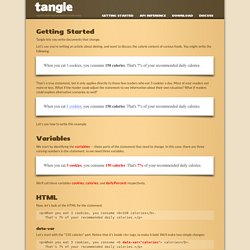

Tangle: Getting Started. Getting Started Tangle lets you write documents that change.

Let's say you're writing an article about dieting, and want to discuss the calorie content of various foods. You might write the following. When you eat 3 cookies, you consume 150 calories. That's 7% of your recommended daily calories. That's a true statement, but it only applies directly to those few readers who eat 3 cookies a day. When you eat 3 drag cookies, you consume 150 calories. Let's see how to write this example. Variables We start by identifying the variables — those parts of the statement that need to change. When you eat 3 cookies, you consume 150 calories. We'll call these variables cookies, calories, and dailyPercent respectively.
Now, let's look at the HTML for the statement. <p>When you eat 3 cookies, you consume <b>150 calories</b>. Data-var Let's start with the "150 calories" part. <p>When you eat 3 cookies, you consume <b data-var="calories"> calories</b>. Span Now, let's look at the "7%" part. Class id JavaScript. Chris Hildenbrand's Blog - 2D Game Art For Programmers - Part 2. The following blog post, unless otherwise noted, was written by a member of Gamasutra’s community.

The thoughts and opinions expressed are those of the writer and not Gamasutra or its parent company. After the initial playing around with circles and squares, learning a little bit about the fills and combining objects [part 1] , I would like to move on to a basic scene. Having more fun with gradients: Let's take the gradient fill to the next level and work with colour and alpha to create a simple underwater background. Hint:Use the 'Page Up' and 'Page Down' key to adjust the order of objects [e.g. place the sea anemones in the mid ground behind the light rays.] I would like to add more life to the underwater scene and create some fish.
I usually do a quick google image search for a reference image to get a better idea what I am going to create. It works great as the main body is kind of squarish and the front has a triangular shape. Staying in shape... the Clip Tool... Chris Hildenbrand's Blog - 2D Game Art For Programmers - Part 1 [updated] {*style:<b>Introduction: </b>*} Creating your own art work is a necessity for most independent developers. Due to the budget restraints or in a lot of cases the complete lack of a budget a lot of young indie game developer can't afford to hire an artist or buy art assets.
With the help of free software like gimp, inkscape, truespace, daz studio and vue pioneer (just to mention a few) combined with a basic understanding of art creation pretty much anyone can create impressive and professional looking results. I will try to start with some basic ideas and exercises to improve this kind of understanding. Let me start by clarifying some common believes when it comes to creating game at. No, you don't! For the full time game artist upgrading your tools to ' industry standards' makes sense. No, it won't. {*style:<i> "I can't do art.
Yes, you can. Yes, you do. High Expectations: One of the main problems facing independent developers are the expectations they have themselves. Defining a theme: Circle Navigation Effect with CSS3.